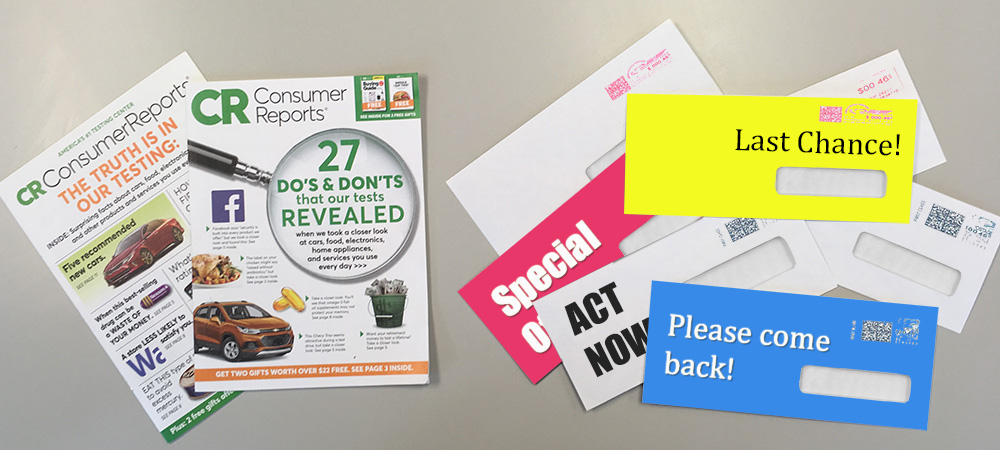

I have always loved magazines. They’ve been a portal to the world since I was a child, and I’ve always been engaged by the medium’s physical nature.
Because I’ve subscribed to scores of magazines over the years, I’ve seen my share of subscription renewal campaigns.
Frankly, I’ve rarely been impressed by a magazine publisher’s subscription renewal campaign. It’s often the same messaging … “We want you back!” or “Last chance!” and “Special offer. Act now!”
But, when I recently received a subscription renewal campaign from Consumer Reports, it got my attention.
Instead of a renewal letter, Consumer Reports (CR) sent 16-page excerpts of their magazine that were chock full of examples of the valuable information and insights they provide. These promotional magazines are often referred to as magalogs.
Their message wasn’t locked away inside an envelope. And their value statement wasn’t lost inside a form letter encouraging me to renew.
Instead, they provided their value statement in a visually engaging short-form magazine format.
I picked it up. I flipped through the pages. I felt compelled to renew, and I decided to act.
It wasn’t until the next day that it dawned on me that Consumer Reports’ subscription renewal campaign had succeeded where so many others had failed. And that was when I decided to contact their marketing group to learn more about the campaign in order to share it with Walsworth’s blog readers. I wanted to share their insights about subscription renewal efforts like email campaigns, mailed renewal letters, magazine excerpts, blown-in inserts, polybag inserts, etc.
Here is what I learned from Dawn Nelson, Senior Director of Marketing at Consumer Reports.
What touchpoints does Consumer Reports utilize to encourage subscription renewal for the print magazine?
Dawn Nelson: For renewals, we use traditional renewal letter mailings along with emails where possible. For members enrolled in our continuous service program, who receive the magazine with uninterrupted service and then a bill about two months before their expiration date, the bill is the way they pay and renew to continue their service.
Gift mailings that encourage a member to renew their own magazine and give a gift to someone for free is another method.
While our magazine insert cards and “free standing insert” magalogs in newspapers twice a year are meant to get new members, sometimes existing members use these options to renew an existing membership.
What is the approximate percentage breakdown of re-subscribers for each of the renewal touchpoints?
DN: For our traditional renewal mailings, approximately 90 percent renew through our renewal mailings. The remainder renew through emails and insert cards.
Are the 16-page magalogs sent to all readers with lapsing subscriptions, or a specific subset?
DN: These “magalogs” (blend of magazine/catalog) are an acquisition technique mailed to people who are not currently members of CR, or to former members who have let their magazine expire and whom we’re trying to get to re-join.
We start those efforts when someone’s membership is 6 months expired to ensure we’ve allowed for all renewal and post-expire renewal efforts to have mailed. We use proprietary models that CR statisticians build to help us find those people who are most likely to re-join so they could be six month expired up to several years expired.
What is the approximate cost comparison between CR’s renewal campaigns that are mailed?
DN: Compared to a renewal letter that mails at a third class non-profit rate (we’ll call that 1x), the continuous service mailings are bills that mail first class, making them about 2.7x.
The magalog is not a standard renewal, but for comparison, it is about 1.75x the cost of a renewal letter mailing based on high volume rollout costs.
What renewal campaigns has CR abandoned because past attempts showed they were overly expensive and/or ineffective?
DN: In the past, CR used to call our members and ask them to renew. At the same time, CR started an advocacy campaign to stop robo-calls, which put the practice of calling members at odds with the changes we were promoting in the marketplace. So, we stopped it.
Another tactic we abandoned several years ago was a renewal wrap – a targeted promotion covering the magazine with a card for the customer to return if they decide to renew. The paper stock costs were high, and we still needed to bill the customer for the order if they returned the card, so we stopped that too.
Do you have any other insights you’d like to share with our magazine clients regarding subscription renewal efforts?
DN: There are three types of renewals:
- Regular renewals, comprised of renewal mailings that typically begin six months in advance of the customer’s last issue,
- Auto Billing, continuous service that is billed annually, where bills begin mailing about two months in advance of the customer’s last issue, and
- Credit Card Auto Renewal, continuous service with annual charges on a credit card, where the customer is notified about 30 days prior to the credit card charge.
Credit Card Auto Renewal has the highest renewal rate and is the most desirable renewal offer for Consumer Reports.
My advice is to always look at acquisition response rates and retention rates together. Some acquisition packages have a high response rate, but may attract a customer who doesn’t renew well. It’s important to look at the results in terms of a longer term customer value that maximizes your brand’s profitability.
Walsworth is grateful for the insights provided by Dawn Nelson and Consumer Reports. We would like to hear your subscription renewal insights. Comment below or send a note to Contact Us.
